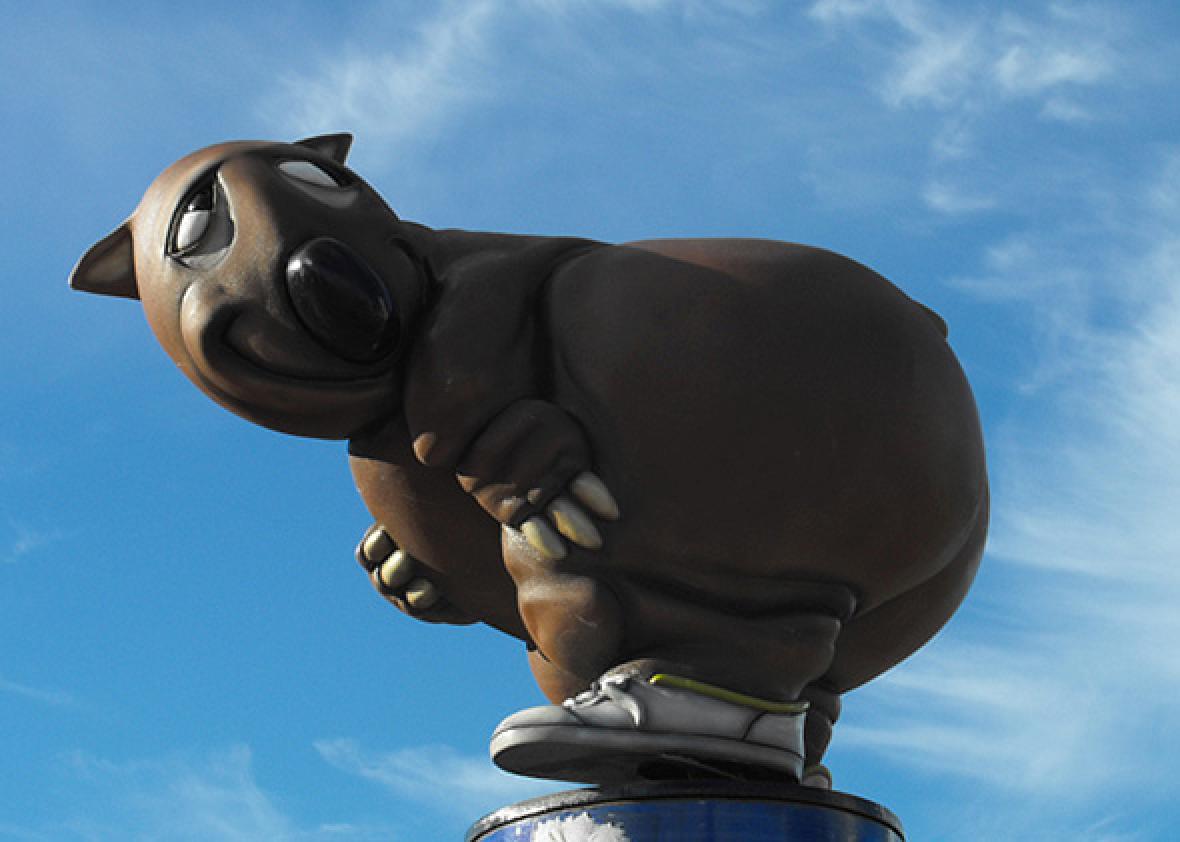The 2016 Olympic Games are underway in Rio de Janeiro, and despite all the problems, there’s one thing Brazil has done exactly right: creating forgettable Olympics mascots. This time around it’s Vinicius, a yellow catlike creature who has the qualities of several Brazilian animals combined, and Tom, the mascot of the Paralympic Games, who has the qualities of a tree.
Like the best Olympic mascots of yore, Vinicius and Tom are well-suited to plush toys and licensing deals and will be completely forgotten within a year. There are no obvious missteps here, like giving Wenlock and Mandeville cameras for eyes in surveillance-camera-ridden London in 2012 or whatever was going on with Atlanta’s Izzy in 1996. Vinicius and Tom can look forward to a happy future of slowly shedding fuzz at the bottom of toy boxes for the next few years before joining Waldi the dachshund, Amik the beaver, and Hidy and Howdy the polar bears in peaceful oblivion. But there’s one mascot you can’t buy in plush form: Fatso, the fat-arsed wombat, the battlers’ prince*, the bane of the Australian Olympic Committee, and the hero of the 2000 Sydney Olympics.
Fatso was dreamed up by Australian comedians John Doyle and Greig Pickhaver, who had hosted a radio show since the 1980s called This Sporting Life. On the show and its various spinoffs, Doyle appeared in character as ex-athlete “‘Rampaging’ Roy Slaven” and Pickhaver played “H.G. Nelson,” an announcer, as they skewered sports and sports coverage. In 2000, they were hired by Australia’s Channel Seven to host a program called The Dream with Roy & HG, where they provided nightly Olympics coverage featuring straight-faced nonsense commentary, like their gymnastics coverage discussing how well competitors executed moves like the “Hello, Boys!” and the “Crazy Date.” But their greatest achievement by far was Fatso.
The official mascots that year were a duck-billed platypus named Syd, a kookaburra named Olly, and a spiny anteater named Millie; the kindest thing you could say about them was that they weren’t Izzy. Roy and H.G. dubbed them “Syd, Ollie, and Dickhead.” They’d been chosen via a process designed to select any animal except the stereotypical kangaroos and koalas, a fine idea that was somewhat undercut when the Australian Olympic Committee introduced its own licensed mascot, the Boxing Kangaroo. Enter Fatso.
Fatso was exactly what his name implied: a wombat with an anatomically implausible butt. Like spiny anteaters and duck-billed platypuses, wombats are native to Australia; unlike the monotremes, wombats don’t look like a horrible mistake of evolution. Fatso, designed by former Disney animator Paul Newell, was simultaneously a rebuke to the entire idea of official mascots and their cash-grab merchandising and, incidentally, a much better mascot than the real thing. Fatso was cute. Fatso had personality. Fatso was memorable. “People take him to their hearts,” Nelson said on the show. “He talks to people around the world. The little guy stands for all that is good and decent about people overcoming hardship. He’s the battlers’ prince.*”
Fatso’s first appearances on The Dream were animated. While Roy and H.G. rolled footage of bad athletic performances, Fatso would appear at the bottom of the screen and, in Roy’s words, “let the big arse do the talking.” Once the show had a plush Fatso manufactured, things started getting out of hand. Australian athletes took Fatso to the medal podium with them, angering Olympic officials, who reportedly sent a written request to The Dream’s network asking them to keep the wombat away from medal ceremonies. Not surprisingly, this hit international news, leading to a press conference in which stone-faced International Olympic Committee members denied he’d been banned.
It seems the trouble was with Australian officials, not the IOC—when journalists asked Australian swimmers Michael Klim and Grant Hackett why they had brought Fatso to their medal podium in the first place, Australian Olympic Committee official Peter Montgomery stepped in and told the press, “It’s a matter of some commercial sensitivity at the moment and I would prefer not to answer the question.”
But Fatso’s fame could not be contained. Roy and H.G. loaned him to foreign newscasters for guest appearances, and the men’s marathon competitors were greeted by a banner reading “Fatso! Fatso! Fatso!” For the final episode of The Dream, Roy and H.G. staged a diving competition in which plush dolls of Syd, Ollie, Millie, the boxing kangaroo, and Fatso plummeted off a high-dive platform.
Fatso won, of course. And unlike so many other Olympic heroes, the fat-arsed gold medalist never tried to cash in on his fame. (No doubt he was aided in this endeavor by the IOC’s lawyers but still.) Only two Fatso plush dolls were ever made; one was auctioned off for charity after the Olympics, and Roy and H.G. kept the other. But although he never embraced commercialism, Fatso did eventually become semi-legitimate. Outside of Sydney’s Stadium Australia, where the games were held, a statue of Fatso was erected as part of an official monument to Olympic volunteers. The statue was stolen in 2010, but Fatso, the fat-arsed wombat, will live on in our hearts forever. Or at least longer than Izzy.
*Correction, Aug. 8, 2016: This post originally misidentified Fatso as “the battling prince” and misquoted H.G. Nelson as using the same nickname. He is “the battlers’ prince.” “Battlers” is an Australian term for the working class, contrasting Fatso’s fans with those of white-collar official mascots Syd, Ollie, and Millie.
